Whether you’re a seasoned trekker or planning your first Himalayan adventure, knee pain can turn an exciting journey into a challenging trip. Anyone who has experienced the sharp knee pain in the mountains knows how it can ruin the entire trekking experience. But here’s the good news – with proper knowledge and preparations, you can avoid knee pain on your trek and daily life as well.
In this guide, we’ll explore the common reasons for knee pain during trekking and share practical tips to keep your knees healthy on the trail, allowing you to focus on what really matters – the breathtaking views and unforgettable moments of your trek.
Reasons behind Knee Pain during Trek
Every trekker has a different reason for the knee discomfort. Let us look at the most common reasons below.
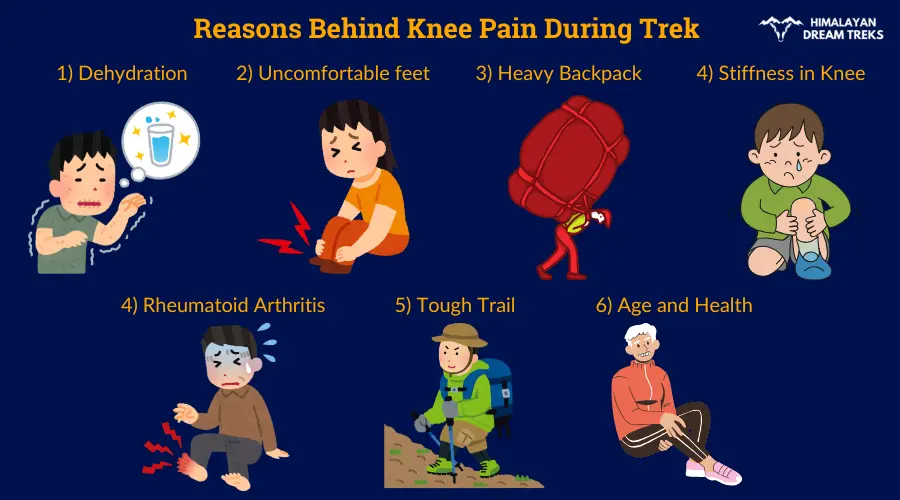
Dehydration
Dehydration might be a reason behind your knee pain. When you are dehydrated, the lack of water and electrolytes declines the production of synovial fluid. It is a liquid responsible for maintaining joint health by providing support, cushioning, and decreasing friction. So, the low levels of synovial fluid lead to the increase of friction in joints and ultimately cause knee discomfort.
Foot Comfort or Uncomfortable Feet
If you are putting your soles on a loose or unfit shoe, then you have to put extra force and effort into hiking smoothly. And that will create stress on your knee as well as your ankle. This stress can cause pain in your ankle and knee joints.
Heavy Backpack
If you are on this adventure with a heavy backpack, then it can surely harm your knee and other body parts. Hiking in uphill and downhill ascents is already a challenging task, and when you do it with a heavy weight on your back, it can create issues for you. That extra weight will put stress on your knee, slow down your speed, and even imbalance you.
Stiffness in Knee
When individuals who follow a sedentary lifestyle go on the trek without any physical preparations, they are more likely to suffer from knee discomfort. It is because of their weak muscles and lack of flexibility in the knee due to sedentary habits.
Rheumatoid Arthritis, Gout, or Other Knee Injury
If you are already suffering from arthritis, Gout or other knee injuries, then there are high chances of knee pain while trekking.
- Rheumatoid Arthritis, being an autoimmune disease, impacts knee health by causing swelling in joints.
- Gout is the condition in which uric acid crystallizes in the joints and causes pain and discomfort in the knee consequently.
Tough Trail
When you hike on the steep ascent for long hours without taking breaks in between, it affects your entire body and your knee. During trekking, the knee remains in movement consistently, so long hours of movement can lead to fatigue and knee Pain.
Age and Health
Generally, trekkers who have crossed the age of 40 suffer from knee issues more compared to younger age people. So, considering your age and health history, you should consult your doctor before commencing the challenging paths of the Himalayas.
Ways to Prevent Knee Pain on Trek
Take care of hydration.
Being aware of your hydration level is essential during trekking. To prevent knee pain due to lack of lubrication, you must drink water every half an hour. Along with it, you should consume electrolyte-rich drinks and dry fruits. Raisins, almonds, walnuts, and sunflower seeds are some of the best sources of electrolytes, and they are lightweight and easy to carry.
A good hydration level reduces your chances of knee pain. And if you are the one who forgets to drink water, then as we recommended set reminders in your phone/smartwatch.
Exercise before going on a trek
Following the Pre-Trek body training routine can overcome the stiffness and train your body to hike for long hours. Pre-Trek Body Training includes a combination of exercises that mainly focus on strengthening your limbs. These exercises improve your muscle’s strength and movement, therefore providing flexibility to your body.
Here are some common exercises that you must practice before the adventure begins:
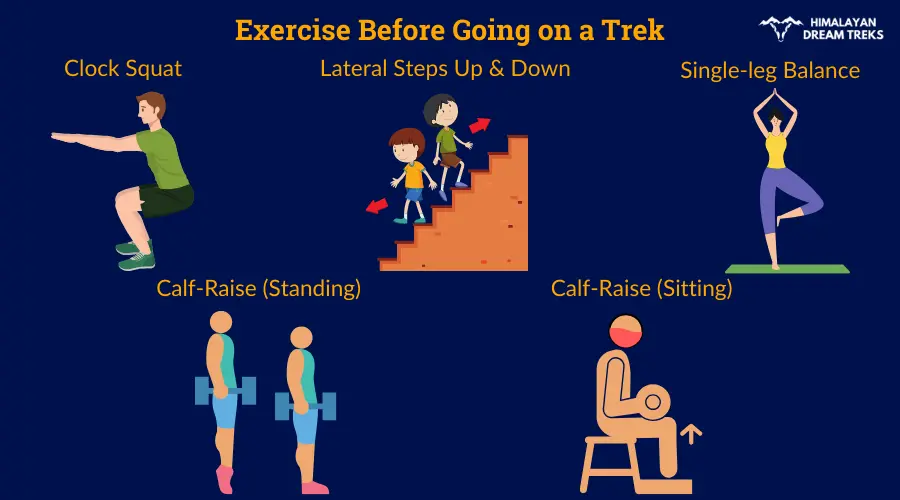
Clock Squats
In clock squats, you balance your body weight on one leg and bend your knee forward while extending the other in different directions, one at a time: forwards, sideways, and backward.
This move focuses on strengthening your quads, hamstrings, and glutes which results in boosting your knee power.
Lateral Steps Up & Down
To practice this, put your one leg on a solid box and start making regular ascent and descent motions. It helps you increase your leg stability and stimulate muscle growth.
Single-leg Balance
The single-leg balance exercise requires you to stand on one leg while the other one is in the air, or you can bend one of your legs up behind you. It provides you with enough strength and enhances your balance capabilities.
Calf-Raise
This exercise can be done in two ways: whether in a standing or sitting position.
- For standing calf raise, bend your knees, try to balance yourself on your foot fingers and front part, up and down. Repeat the process for as long as you can.
- For sitting calf raises, place two dumbbells on your knees to keep them unmoving, then lift your heels off the ground as much as you can. It’s a toning exercise that trains your ankle. It targets muscles such as gastrocnemius and soleus.
Utilize the Trek Gears
The trek tools in any kind of trek play a great role in providing support. They ensure your safety as well as comfort, which transforms your trek into a more exciting and enjoyable one. However, you still cannot pack everything because it would tire you more quickly to load things on your back.
We have made a list of essential trekking gear that you must pack for a trek to the Himalayas. Out of the gears given below, Trek Pole is the only tool that directly prevents knee pain. Other gears play no role in avoiding knee pain directly; however, they assist you by avoiding the incidents that cause injuries.
Trek Poles
These walking sticks eliminate chances of falling, reduce fatigue, and stabilize balance on rocky and slippery roads. Hiking with the support of a trek pole will lessen the stress on your knee. It’s a must-have tool for a trekker to avoid knee issues.
Head Torch
The head torches are attached to our heads, allowing you to enjoy a hand-free facility during your treks in the dark. Overall, it improves your visibility and helps you avoid dangerous obstacles in your way.
Navigation instruments
These instruments mainly include maps and compasses. They help you find the right way and direction for your trek in case you are not accompanied by any guide or locals in the particular region.
Raingear
The Himalayan altitudes often face sudden climate changes, so it becomes necessary to be well prepared. Useful rain gear to prevent knee pain are –
- Water-resistant shoes with good soles and high ankle to make your hike easy on slippery and muddy trails.
- A raincoat or a poncho to prevent both yourself and your backpack from getting wet (being wet or carrying a damp bag again hinders your trek).
Buy the comfortable Shoes for the trek
A pair of perfect sole-hugging shoes with deep grooves can support your limbs while hiking on challenging zig-zag trails of the Himalayas. When you trek wearing perfect shoes, your lower body stays in a comfort zone, reducing the chances of knee Pain and discomfort.
Shoes play a vital role in preventing any kind of lower body ache while trekking on difficult trails. By balancing your soles, comforting your feet, and providing you protection from unwanted injuries in challenging terrains.
Hence, you must choose the perfect shoes.
Here are a few recommended shoes for hiking in the Himalayas.
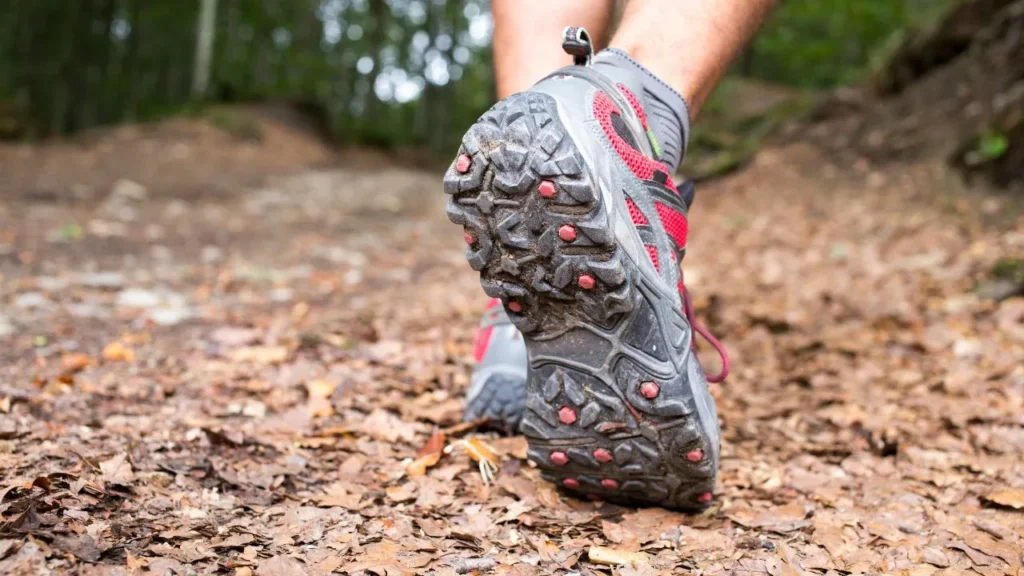
Trail Running Boots
For uneven roads that might comprise pebbles, boulders, rocks, etc, you should go with trail running boots. These are designed to deliver flexibility during the expedition on the trail with their foot-hugging approach.
Hiking Shoes
Hiking shoes are equipped with softer inside soles and strong gripping outside soles . If you are commencing on a Day Trek, then these hiking shoes are the best choice. As they are designed to serve the purpose of short treks.
Mountaineering Boots
These boots are generally required for snowy landscapes, glaciers, and complicated steep climbing. Mountaineering boots are the best choice for going on a Winter Trek.
Boots crafted with insulating fabric on the inside and robust fabric on the outside offer comfortable support to your feet while trekking on a snow-covered trail. Additionally, they have thick soles with a metal plate attached with spikes to have a deep grip on the snow.
Light Backpack (only essential things)
A light backpack that includes only essential things is a tip for every trekker to follow. Moreover, there are many advantages of it:
- It reduces the burden on your knee and helps you trek for long periods with less chance of knee pain.
- It minimizes the strain on your muscles and even allows faster movements without hurting your body.
- The lightweight backpack lets you maintain your body posture, which is a great requirement to avoid body pain while trekking to great elevations.
- A light backpack also reduces your footprint in the mountains.
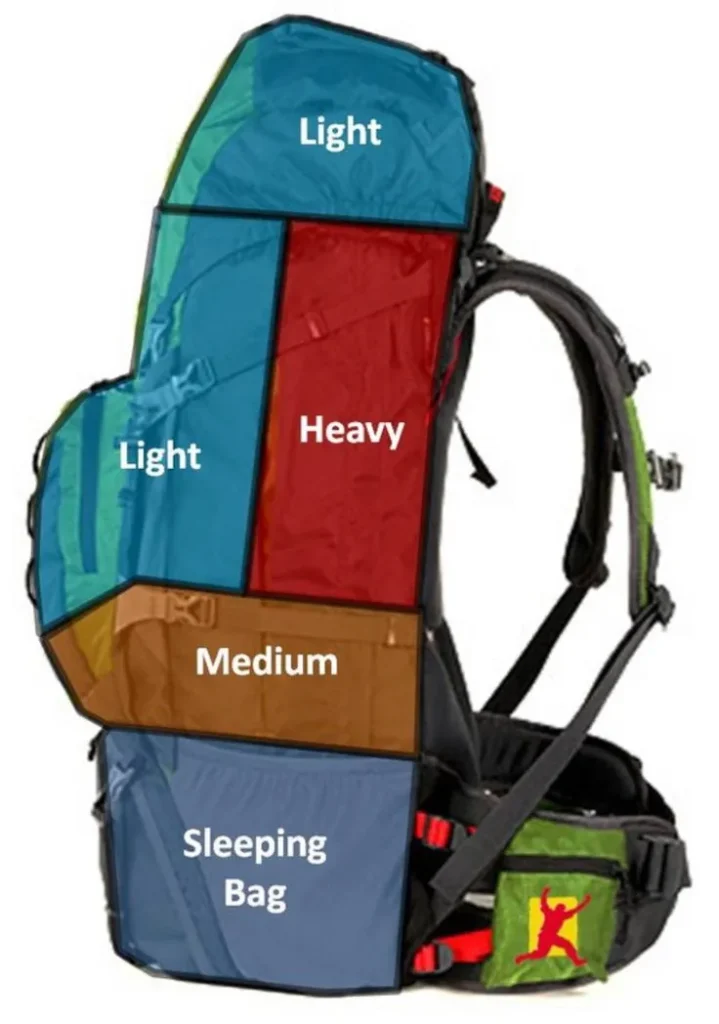
Keep a First Aid Kit
You must include a first aid kit containing the essential things to relieve knee pain in your hiking backpack. Unfortunately, if you get a knee injury or sudden pain, then you can counter the discomfort using these medications.
Things you should keep in the first aid kit are pain-reducing tablets, analgesic spray, knee bands, and heating packs.
Do not over-exhaust
To reach the summit, you need to trek smartly rather than just sweat-giving trekking. To bypass the knee pain, you must take sufficient rest and recover for further adventures. So it’s advisable not to over-exhaust yourself, as it will only make your body feel intense fatigue and it can sore your muscles, eventually leading to knee discomfort.
Concluding Thoughts
Remember, trekking with knee pain will not only ruin your mood, but it can also affect you physically in the long run. This guide is not a rigid set of rules; alter them as per your requirements. Instead of buying new snow boots, you can rent them, divide the food and drinks quota among fellow trekkers, etc.
These tips are given to help you enjoy the magnificent views on trekking for which you came to see. Remember, listening to your body and taking necessary precautions isn’t being overcautious – it’s being smart. Prevention is better than cure.
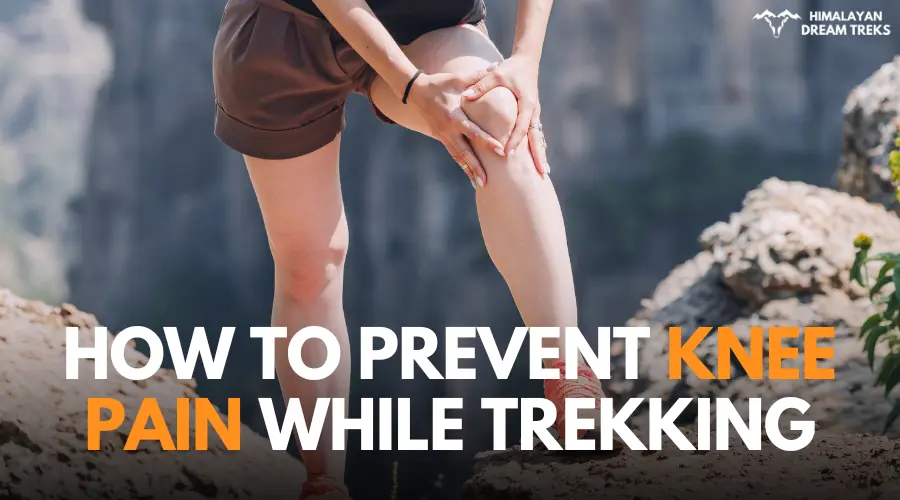
Leave a Comment